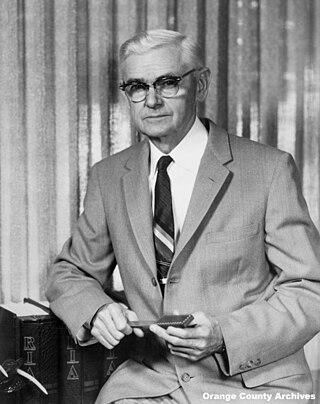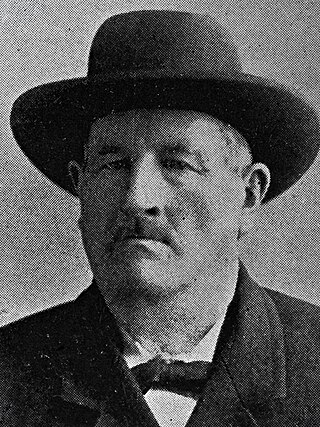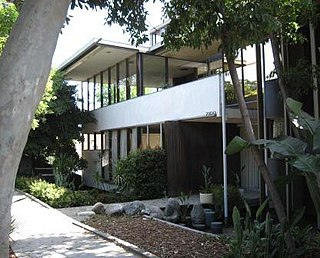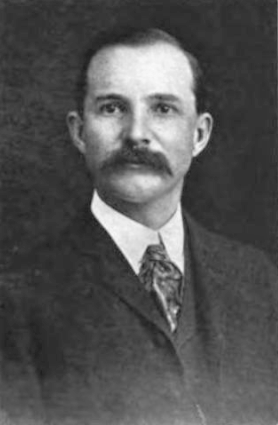Related Research Articles

Walter Marvin Knott was an American farmer and businessman who founded the Knott's Berry Farm amusement park in Buena Park, California, introduced and mass-marketed the boysenberry, and founded the Knott's Berry Farm food brand.
Bernard Cohn was a wool buyer and a capitalist in 19th-century Los Angeles, California, as well as a member of the Los Angeles Common Council, that city's legislative body. It was Cohn who provided former California Governor Pio Pico a sum of money in exchange for all of Pico's property, which eventually led to Pico's spending the rest of his days in poverty. He was also known for maintaining two families, one Jewish and one Catholic, at opposite ends of the town.

Myron Hubbard Hunt was an American architect whose numerous projects include many noted landmarks in Southern California and Evanston, Illinois. Hunt was elected a Fellow in the American Institute of Architects in 1908.

The Phillips Mansion is a Second Empire style historic house in Pomona, Los Angeles County, California. It was built in 1875 by Louis Phillips, who by the 1890s had become the wealthiest man in Los Angeles County. Situated along the Butterfield Stage route, the Phillips Mansion became a center of community activity in the Pomona and Spadra area. It was added to the National Register of Historic Places in 1974, making it among the first 25 sites in Los Angeles County to be so designated.

José Mascarel was a 19th−century sea captain, California landowner, investor, baker, and vintner; and a mayor of Los Angeles, California.

The Broadway Tunnel was a tunnel under Fort Moore Hill in Downtown Los Angeles, California. It extended North Broadway, at Sand Street, one block north of Temple Street, northeast to the intersection of Bellevue Avenue, to Buena Vista Street.

Neutra VDL Studio and Residences, the home of architect Richard Neutra, is located in Los Angeles, California. It is also known as the Neutra Research House, the Van der Leeuw House, the Richard and Dion Neutra VDL Research House II, or the Richard and Dion Neutra VDL Research Houses and Studio. It was designed by Richard Neutra and his son Dion Neutra. The house is currently owned by California State Polytechnic University, Pomona, and is maintained by its College of Environmental Design. The property was added to the National Register of Historic Places in 2009, and was designated as a National Historic Landmark in 2016.

Thomas Jesse Yarnell, known as Jesse Yarnell, (1837–1906) was a California newspaperman who established the Los Angeles, California, Weekly Mirror, which took over the Los Angeles Times in 1881 and later merged with it.
Samuel J. Beck was a metallurgist, land developer, a judge in Montana, and a member of the Montana State Legislature in the 19th Century. He was also on the Los Angeles Common Council from 1878 to 1880 and was its president during 1878–79, in Los Angeles, California.
William Taylor Barnes Sanford (1814–1863) was an American road builder, a landowner and the second postmaster of Los Angeles, California, after it became a part of the United States. He was a member of the Los Angeles Common Council from 1853 to 1854.
Elijah Moulton (1820–1902) was a pioneer settler in Los Angeles, California, after the Mexican–American War, and became one of its wealthiest citizens. He was a member of the city's governing body, the Common Council.
Louis Roeder (1835–1915) was a member of the governing body of Los Angeles, California, in the 19th century, who rose from being a pioneer blacksmith and carriage maker to one of the wealthiest landowners in the city.
John Schumacher was a German immigrant who became a wealthy landowner in Los Angeles, California, and was a member of that city's governing council.

Matthew Teed was a member of the Los Angeles Common Council, the governing body of that city, in various time periods between 1870 and 1888.
John H. Jones and Carolyn or Carrie Otis Jones were a pioneer husband and wife in Los Angeles, California, whose real estate holdings became worth millions of dollars by the beginning of the 20th century. John H. Jones was a member of the Los Angeles Common Council, the governing body of the city.
John Lovell was a 19th-century businessman in Los Angeles, California, the owner of a grocery store and other property and a member of the Los Angeles Common Council, the governing body of the city. He suffered injuries to his head, was sent to a mental hospital and was said to have epilepsy.
James Wesley Potts (1830–1896), known as James W. Potts or J. W. Potts, was a pioneer resident of Los Angeles, California, after that state became part of the United States following the Mexican War. He was a merchant, a landowner and a member of the Los Angeles Common Council, the legislative branch of the city, becoming noted locally as an amateur weatherman nicknamed "The Prophet."
James Velsir was a fireman and politician in 19th century Los Angeles, California.
Otto Guenther Weyse was an American liquor and wine dealer in 19th-century Los Angeles. He was a member of the Los Angeles Common Council and was instrumental in bringing a visiting San Francisco opera company to Los Angeles. He was noted statewide as a man who sent his child to Mexico during a prolonged and "sensational" divorce battle with his French-born heiress wife.

Walter F. Haas was the city attorney of Los Angeles, California. He was an authority on water and riparian water rights.
References
- 1 2 "Funeral of a First Pioneer," Los Angeles Times, December 7, 1906, page II-3(subscription required)
- ↑ John Steven McGroarty, From the Mountains to the Sea (1921), page 193
- ↑ San Bernardino County Museum
- ↑ "Pomona Historical Society". Archived from the original on 2007-02-23. Retrieved 2012-08-28.
- ↑ Location of the Mullally property as shown on Mapping L.A.
- ↑ "Los Angeles County, California, Biographies" [ dead link ]
- ↑ "Number One: What Is Found in the First Issue of the Los Angeles Times," Los Angeles Times, December 4, 1891, page 2(subscription required)
- ↑ "Row Over 'The Wellington,'" Los Angeles Times, January 9, 1896, page 8(subscription required)